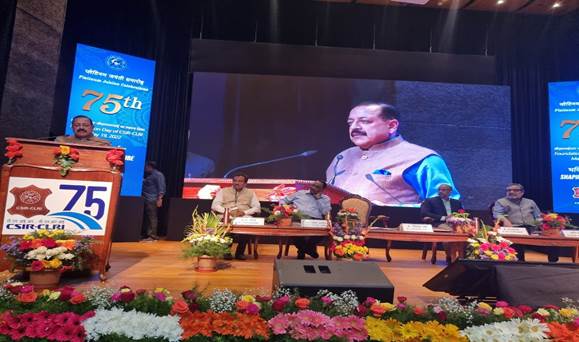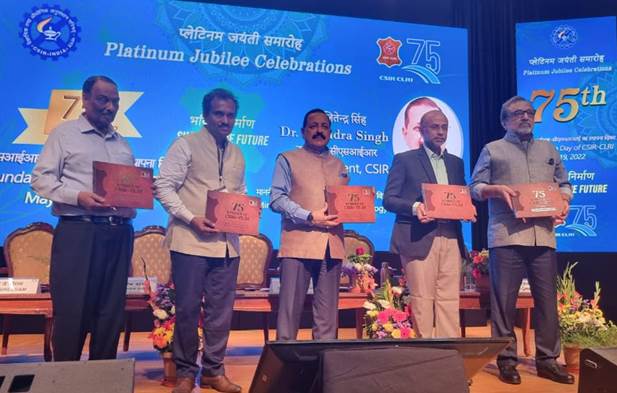Union Minister of State (IC) Ministry of Science and Technology; Minister of State (IC) Ministry of Earth Science; MoS of Prime Minister’s Office and Ministry of Personnel, Public Grievances & Pensions Dr Jitendra Singh said, leather industry in India will aim at net-zero carbon footprint to meet the environmental norms.
Addressing the Platinum Jubilee celebrations of CSIR-Central Leather Research Institute in Chennai today, Dr Jitendra Singh said, the carbon footprint of leather processing activity needs to approach zero levels and the bio-economy of animal skin-derived products is the new mantra of the time. He said, the carrying capacity requirements of the leather sector in locations like Tamil Nadu demand the implementation of Zero Liquid Discharge as the enforced environmental norm, which is under discussion.

Referring to Prime Minister Narendra Modi’s pitch for new innovations and next-generation technologies, Dr Jitendra Singh said, the sustainability of the leather sector is likely to emerge as the new challenge for CSIR-CLRI in its journey from the platinum to the centenary. He said, the new vision for leather research and industry during the next 25 years may need to be on sustainability, net-zero carbon footprint, gaining total recyclability of leather-based materials, bio-economy of animal skin-derived products, and ensuring income parity for workers, besides brand building.
Dr Jitendra Singh offered attractive financial support from DST to Start-ups to come up with innovative and market friendly leather products. He said, efforts are on to prepare customised footwear for Indians by using 3D technology to scan the feet of the person to prepare their footwear. He said 73 districts in the country are included to implement the project in the first phase.
Dr Jitendra Singh said, the leather footwear needs to be designed and developed into foot care solutions with foot hygiene and wearer comfort as the Unique Selling Properties. He said, there are as many as half a million cells in the palm of feet that enable the sweating process and leather enjoys an unmatched potential for transpiration. The Minister also pointed out that Diabetic footwear is one such product that ensures a better quality of life due to the reduction in the abnormal distribution of plantar foot pressure.
The Minister informed that Collagen-based innovative biomaterials for applications in human health care are new opportunities and they could well become co-products of leather, if next-generation leather-making technologies avoid contaminating skin-based matrix materials with lime, sulfide, and many other sensitive chemicals. He said, there is a possibility for CLRI to emerge as the game-changer in the knowledge domain and to make the leather sector matter even more for the new India of the future.

Dr Jitendra Singh said that the Indian leather sector in 1947 provided livelihood opportunities for about 50,000 people only, but today it is widely known that the leather sector supports the livelihood of more than 45 lakh people in the country. He also expressed satisfaction that in 2021, export realization from the leather sector is valued at Rs 40,000 crores. The Minister noted that the role played by a unique partnership among academy-research-industry in which CSIR-CLRI has been the central pin is worthy of commemoration on this occasion. Moreover, the Indian leather sector has played tangible and traceable contributions to social equity and it has been scientifically assessed that technology utilization in the footwear industry has significantly contributed to women’s empowerment. Social equity benefits of women empowerment emanating from the leather industry since 1950 are laudable, the Minister emphasized.
Recalling that the foundation stone of CLRI was laid by Shri Shyama Prasad Mukherjee on 24th April 1948, Dr Jitendra Singh said, founded within the first year of independence of the country, the platinum jubilee of the institute is concurrent with the 75th year of India’s Independence. He added that there are very few national laboratories whose developments have run concurrently with those of the nation.
The Minister also lauded the admirable role of the CLRI in helping the tannery sector in Tamil Nadu to restore operations when the Supreme Court ordered the closure of about 400 tanneries in 1996 through the innovative deployment of “Do Ecology” solutions in all the 764 functional tanneries within nine months. He concluded that this was a landmark contribution to public-funded research in the country and there are several contributions of CLRI that have formed an integral part of the developments of the leather sector in India.
Tracing the evolution of CLRI, Chennai from 1948, Dr Jitendra Singh said, in the first 25 years, the institute may have focused on reaching technologies to the unreached and facilitating the planned development of the sector. During the next 25 years, Indian leather research and industry seem to have focused on modernization and enhancing environmental preparedness. The last 25 years have led to the enhancement of unit value realization from leather in the global market. The new vision for leather research and industry during the next 25 years will be to carve a new niche in world market through innovation and brand building.
<><><><><>
SNC/GB
(Release ID: 1826689)
Visitor Counter : 496
